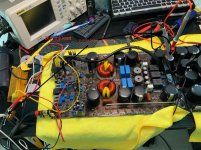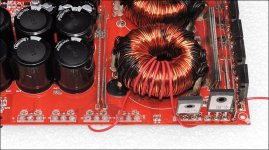Confirm that there is no voltage across the speaker terminals with a load connected across them.
If there is no voltage, connect a load (a dummy load preferred). What is the resistance between the negative battery terminal and the primary ground terminal on the amplifier?
If there is no voltage, connect a load (a dummy load preferred). What is the resistance between the negative battery terminal and the primary ground terminal on the amplifier?
I've never seen one of these ICs that was in UVLO at 9.3v but let's eliminate the possibility. Disconnect the battery and connect the VB terminal to the 12v B+ through a low-value resistor (1.5 ohms if that's what you have).
Confirm that you have 12v across the VS and VB (black meter probe on VS). If you have 12v, check for high-side drive.
Confirm that you have 12v across the VS and VB (black meter probe on VS). If you have 12v, check for high-side drive.
OK will do so it is safe to connect it to the B + (in this case bench power supply out put ) through 1.5 ohm resistor?
I've done it. If there is a problem, the small resistor will burn open like a fuse. I wouldn't ordinarily recommend this but I can't understand why the high-side won't produce output. UVLO is one possibility (although unlikely at 9.36v).
We got high side gate drive! omg the issue was one of my allegator clips was faulty ! I replaced it and it worked with the 9v battery !
I was trying to get some numbers for this repair from one of my amps and used some jumpers that were good last time I used them and 1/2 were open. It looks like they used aluminum wire and it all oxidized.
Never rule out anything.
Never rule out anything.
That's precisely what happened i toom the plastic cover off the alligator portion and the wire was oxidized and corroded. Going to put the 1.5k resistors back and test. Then fit the rest of the tc 4452.
When you install the FETs, make sure that you have none of the various supplies connected to the amp and you made any jumpers or other mods for testing, remove those.
Initial tests on an amp like this is generally best done on low-voltage (on secondary) or limited current for the secondary voltage. Do you have what would be needed for that?
Initial tests on an amp like this is generally best done on low-voltage (on secondary) or limited current for the secondary voltage. Do you have what would be needed for that?
Wil do I'll go back through and make sure everything is reverted to stock configuration. Sadly I do not ! I was trying to get a hold of a cheap amp I could use the voltage rails from. I am going to current limit what I can with the bench top power supply .
oh wow ! Yes it does have 2 rectifiers per transformer. Also when testing is it ok to only fit 1 fet per bank on the low side and high side ?
The hardest part of making your own supply is removing the rectifiers.
You can use 1 per bank. The benefit of using low-voltage is that you can use inexpensive PS FETs for testing. I typically use an IRFP064.
You can use 1 per bank. The benefit of using low-voltage is that you can use inexpensive PS FETs for testing. I typically use an IRFP064.
Oh i seen. Only bad news is i don't have any spare fets on hand besides extra 24n40fs and irfp7350
You can use the high-voltage FETs. When you have the PS FETs, they are more robust and less likely to fail if there is a problem (unlikely if you confirm that all drive signals are good before installing the FETs).
Do you have any small capacitors of approximately 0.01uf?
Do you have a signal generator that can produce a 100kHz signal?
Do you have any small capacitors of approximately 0.01uf?
Do you have a signal generator that can produce a 100kHz signal?
I should have a few capacitors I'll check I do not have anything capable if supplying a 100khz wave though
Do you have the repair tutorial? It would save a lot of time and provide greater detail than I can do here.
- Home
- General Interest
- Car Audio
- Blown Sundown Salt 8 Amplifier

